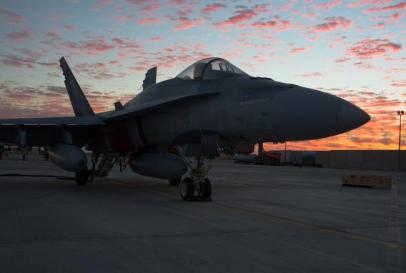Fighter Aircraft and New Canadian Defence Imperatives

See The Simons Foundation's Disarming Arctic Security page for briefing papers on military policies and practices in the Arctic region by Ernie Regehr, Senior Fellow in Arctic Security at The Simons Foundation.
Fighter Aircraft and New Canadian Defence Imperatives
That the Liberal election campaign could make unequivocal promises not to buy the F-35 fighter and to withdraw Canadian CF-18 fighter aircraft from their current mission in Iraq and Syria, without triggering any significant blowback from Canadians or the Canadian defence community, testifies to the declining relevance of fighter aircraft, both to North American security, including the Arctic, and to Canadian military operations and peace support missions beyond our borders.
The F-35 continues to be vigorously promoted by influential security analysts and former military officers, some pundits, and many in the Department of National Defence (DND) itself, but the new Government will probably have little difficulty making good on its campaign promise not to buy it, largely because DND has never been able to convincingly portray it and its “fifth generation” attributes as integral to, never mind an urgent requirement for, meeting Canada’s defence needs in North America. Indeed, it’s hard to characterize any fighter aircraft as absolutely essential – in the way, for example that coastal radars are absolutely necessary if Canada is to effectively monitor the approaches to Canadian air space, or in the way that helicopters, patrol ships, and ice-breakers are essential for meeting the basic search and rescue, public safety, and frontier monitoring responsibilities of a northern sovereign state. Not since the Soviet manned bomber threat gave way to the missile threat in the post-Sputnik late 1950s have fighter aircraft occupied a place of fundamental or critical importance in Canadian security strategy.
And the promised withdrawal of the CF-18s from the Middle East also turned out to be uncontroversial, despite some calls for second thoughts after the attacks in Paris on November 13. Again, that’s because there is in fact no international consensus, and scarce evidence, that the bombing campaign of the US-led coalition, with Russia’s bombing added to the chaotic mix, is making a critical contribution, either to the defeat of the Islamic State or, especially, to ending the civil wars and restoring some semblance of order in Iraq and Syria. While it is certainly possible to point out specific targets destroyed and tactical defeats handed ISIS by Canadian or other fighter aircraft bombing missions, and while the Canadian presence is welcomed by coalition partners as a statement of political solidarity, there is no sense in Canada or apparently among our coalition partners that the Canadian combat presence is seriously consequential.
That said, no military leader is likely to argue that Canada should no longer be in the fighter aircraft business, nor did the Liberals, or the NDP for that matter, promise that in their campaign commitments. So the new Government has now established an office – designated the Future Fighter Capability project – to oversee the procurement of aircraft to replace the CF-18 fighter. The general guidelines to be followed seem clear enough (though hard to meet): the purchase is to “match Canada’s defence needs;" the primary mission of the replacement aircraft is to be the defence of North America; the decision is to be made following “an open and transparent competition;” the F-35 is not a suitable option; and the replacement aircraft should be significantly less costly than the F-35.
That new office notwithstanding, there are other signs from the new Government that point to a reduced emphasis on fighter aircraft. The chapeau sentence to the policy very briefly summarized in the Minister of National Defence Mandate Letter calls for structuring the Canadian Armed Forces “to protect Canadian sovereignty, defend North America, provide disaster relief, conduct search and rescue, support United Nations peace operations, and contribute to the security of our allies and to allied and coalition operations abroad.” Domestic responsibilities include “surveillance and control of Canadian territory and approaches, particularly our Arctic regions,” and for overseas operations the emphasis shifts from coalition operations, though those are included, to a renewed “commitment to United Nations peace operations.” Couple that with the intended switch in the current Middle East mission from air combat to training ground troops and humanitarian support, and it becomes clear that fighter aircraft are of declining relevance. Continue reading....
Ernie Regehr, O.C. is Senior Fellow in Arctic Security at The Simons Foundation, and Research Fellow at the Institute of Peace and Conflict Studies, Conrad Grebel University College, University of Waterloo.